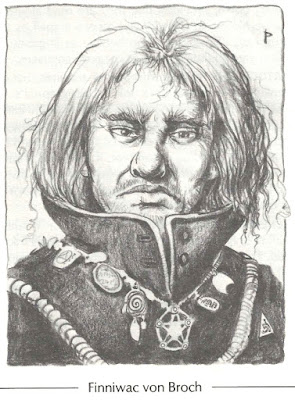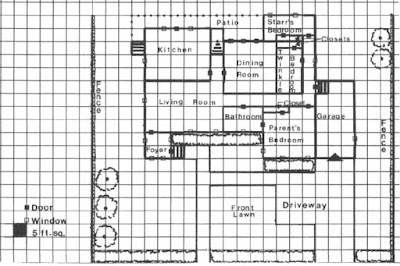 |
| Art by Stephan Peregrine |
Treasure Vault – published by Flying Buffalo in 1984 – is one of the Catalyst Series of products. The second page tells us, “Each book in the [Catalyst] series provides a 'catalyst to your imagination' – something to give your imagination a boost towards better gaming.” Evidently, there were hopes that Treasure Vault would become a series of books along the lines of the Citybooks or Grimtooth's Traps. This may be inferred from another statement on page 2, “Treasure Vault is Flying Buffalo's trademark name for those Catalyst game booklets which describe valuable goods and scenarios for use in role playing games.” (my emphasis)
Anyway, the subtitle of Treasure Vault is, “a collection of 26 unusual items with 38 interlocked personalities in 57 suggested scenarios for any role playing system.” The Introduction qualifies the claim of “any role playing system” with the clarification “at least those with a fantasy/medieval outlook.” With regard to “interlocked personalities,” I guess “interlocked” is supposed to mean “associated.” The Introduction also states:
Most of the items listed here have some sort of origin or background material involving “ancient history.” If these clash with a particular system (for instance: if your world has no orcs, there couldn't very well be an Orc War), change or delete them so that they fit. Remember, change the item to fit the world, not the other way around.Whew, what a relief!
Treasure Vault is mainly the work of Steven Howard whose other RPG efforts are limited to (1) a yawn-inducing 1⅓ page article in Dragon about monk alignment and (2) being one of the designers of the Millennium role-playing game. Treasure Vault may have failed as a series because there was essentially only one contributor to the premier volume and only 40 pages of material. Stephan Peregrine (listed as 'Stephen' on the cover) provides the illustrations and authors one of the items. Peregrine has many art credits in RPG products and he seems to have written one of the items in Citybook II: Port o' Call. Outside of the RPG industry, Peregrine is associated with the Furrlough comic book. (Yes, I just linked to a wiki for furries. No, I'm not going to create a 'furry' tag for this post.)
Despite the promise of 26 items, I count only two dozen items divided among three categories: 'Weapons and Armor', 'Jewelry', and 'Miscellaneous'. There are seven weapons (and no armor items), seven pieces of jewelry, and ten miscellaneous items. Perhaps two items were edited out in order for the book not to exceed forty pages. Yet there are still 38 personalities and 57 suggested scenarios. Let's take a look at one of the miscellaneous items, along with the associated personalities and scenarios.
Wildith's Quill is a magic pen fashioned by the eponymous alchemist. Wildith has been dead for fifty years and although his “magical inks of various sorts are still widely used,” his quill is not well known and its magical properties would not be suspected by most people. If normal, mundane ink is used, the quill can be commanded to transcribe dictation. Other powers are dependent upon using special inks. With linguist's ink, the quill can “translate between any two common languages.” With wizard's ink, “magical spells can be written down, provided they are read aloud, of course.” Cartographer's ink allows the quill to “draw an accurate map, in a given scale, of an area around the Quill, up to a radius of ten feet.” Finally, with alchemist's ink, the quill is able to “keep track of a conversation involving up to seven people in up to seven different languages.” Unfortunately, we are not informed as to what makes these inks special without the quill. Cartographer's ink, for instance, “sells for 100 gold pieces per dram.” Why would anyone buy it? If no one would buy it, why would anyone make it? Also, mapping an area of a ten foot radius wouldn't cover a the floor plan of a house. A map of a nice, medium-sized room is totally doable...for 100 GP. This might be another reason the Treasure Vault series didn't take off.
Two non-player characters are “interlocked” with this item: Finniwac von Broch and Dorman Tweed. The details for Finniwac are as follows.
Human. Ht: 5'7". Wt: 150 lbs. Age: 39. Fighting prowess: poor. Magical ability: poor in C5.As might be expected, Treasure Vault employs the Citybook 'system' of description. “C5” refers to communication magic. “Finniwac is a well-to-do alchemist,” we are told, “He is quite skilled and can easily manufacture any of Wildith's magic inks.” I'm not sure how being “quite skilled” in alchemy equates to a poor ability in communication magic, but whatever. “Finniwac is not a very likable fellow,” we also learn, “There's nothing really terrible about him; he's just anti-social.”
Dorman Tweed is Finniwac's apprentice.
Human. Ht: 6'. Wt: 205 lbs. Age: 23. Fighting prowess: average. Magical ability: poor, C5.As opposed to his master, Dorman “is handsome, friendly, and well-liked.” He works for Finniwac in order “to put himself through magic school.” His description concludes with, “He will readily befriend a party of player characters, especially one including an experienced magician.”
Three scenario suggestions are provided for Wildith's Quill. In the first scenario, the PCs obtain the quill and figure out its powers. They then go to Finniwac to procure some alchemist's ink. (Because they want to record a multi-lingual conversation? I hope this doesn't break anyone's campaign.) Finniwac, however, needs a certain ingredient to make the ink – the eye of an undead wizard. If the characters procure the ingredient, Finniwac will let them have a dram of alchemist's ink for free. What a bargain! In the second scenario, Finniwac hires the PCs to obtain a rare ingredient. While fetching the ingredient, they find the quill. “Finniwac might show them how to use it,” the book states, “and he might not, depending on his mood at the time.” (I think this is supposed to be dramatic tension.) In the third scenario, “The players are hired by Finniwac to retrieve the quill.” Dorman Tweed is not mentioned in conjunction with any of the three suggested scenarios, so maybe “interlocked” isn't the right word.





